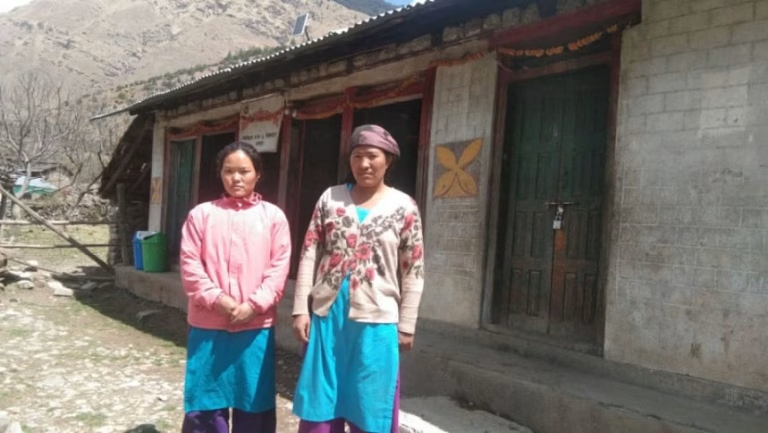In the remote areas of Baglung District, Nepal, childbirth often becomes a dangerous gamble. Despite national promises to improve healthcare, women in municipalities like Nisikhola and Dhorpatan still struggle for safe maternity services. Long travel distances, poor infrastructure, and lack of medical facilities put mothers and babies at serious risk.
Lack of Basic Maternity Services in Nisikhola
In Ward 5 of Nisikhola Rural Municipality, the situation is critical. The community health unit in Niseldhor does not have a birthing center. Only two staff members, auxiliary nurse midwife (ANM) Yam Kumari Gharti and office assistant Prem Kumari Gharti, work there. They treat around 10 to 12 patients each day but have very few tools.
The nearest birthing center is a three- to four-hour walk away. To reach the municipal office in Nisi, women must walk for 10 hours. Yam Kumari shared her experience: “When I was pregnant, I rented a room in Palpa for a month before giving birth.” She was one of the few who could afford to do this.
Prem Kumari, on the other hand, delivered all five of her children at home. “We were never taught to go to the hospital. There was no way to leave the house, and no one to help,” she said. Many women in the region tell similar stories.
Bad roads, dangerous rivers like the Bhujikhola during the rainy season, and high travel costs—up to Rs10,000 for a vehicle in winter—make it nearly impossible for most families to reach a hospital.
Poverty and Marginalization Deepen the Crisis
The situation is even worse because of widespread poverty. About 77 percent of people in Dhorpatan valley, including Niseldhor, belong to the Dalit community. Most families earn a living through cattle herding and farming potatoes. With little income and almost no government support, safe childbirth remains out of reach.
Dhorpatan Municipality has tried to improve conditions by building a birthing center near the Dhorpatan Hunting Reserve. But the center struggles with serious problems. “The baby warmer broke four months ago, and we have no replacement,” said ANM Sita Budhamagar. “We use firewood—about 8 to 10 bundles per birth—to keep newborns warm.”
The cold environment also causes longer labor and more birth complications. When emergencies happen, families sometimes try to hire jeeps to rush to Burtibang. But the trip is expensive and not always possible.
Few Institutional Deliveries and Limited Services
In just one month, 334 people visited the Dhorpatan health post. Yet, during the current fiscal year, only 16 women gave birth at the facility, even though there were 35 antenatal visits. Most women still deliver at home, often helped only by family members or traditional birth attendants.
Without proper equipment or trained medical staff, the health post can only offer basic check-ups and minor treatments. Women with serious problems must go to distant hospitals—if they can get there in time.
Hospitals Still Under Construction
Both Nisikhola and Dhorpatan had plans to solve these problems by building hospitals. Construction of a 10-bed hospital in Nisikhola started in 2020 but remains unfinished. In Dhorpatan, work on a health facility began in November 2023 but has also stalled. Only half the work is done. The contractor stopped after receiving Rs87.6 million out of the promised Rs175 million, saying they had not been paid.
Baglung District Hospital in Burtibang, first announced in 2010, only opened in 2024. However, it still lacks enough equipment and trained doctors. Nurse Parbati Aryal said the hospital treats about 250 patients each day and handles around 20 deliveries each month, including caesareans. Still, many critical patients must be referred to Palpa or Butwal because of missing surgical tools.
High Rates of Home Births Continue
According to the Provincial Public Health Office, only 69 percent of births in Baglung take place in medical centers. When adding those who travel to cities like Pokhara, Palpa, or Butwal, the number rises to 80 percent. However, remote areas like Nisikhola, Dhorpatan, and Badigad still see many home births.
“Geography and lack of awareness are big problems,” said Laxmi Sharma, a public health officer in Baglung. “We run regular awareness and vaccination campaigns, but in the most remote places, the message has not reached everyone.”
Sharma also mentioned that she only recently learned about the broken baby warmer in Dhorpatan. “We supplied it last year. Now, we will check if it can be repaired or replaced,” she said.
Financial Support Makes a Difference
Nepal’s government offers Rs2,000 for transportation costs for institutional births. Nisikhola adds another Rs2,000. Galkot Municipality even offers an extra Rs4,600. Thanks to this, Galkot has almost eliminated home births, according to local health officials.
But in Dhorpatan, many women still avoid health centers. ANM Hiramati Gharti from Bhalkot Health Post shared a worrying case: “We referred a woman to Burtibang, but she chose to deliver at home. She started bleeding badly afterward. We rushed her to the hospital in an ambulance. Thankfully, she survived.”
Community Solutions Offer Hope
Despite many hardships, some local initiatives are helping. In Nisikhola, a maternity waiting home in Boharagaun has helped more than 160 women since it opened. Free ambulance services and regular check-ups are available for pregnant women, the elderly, and people with disabilities.
Still, as ANM Yam Kumari Gharti said, “We do our best, but without enough staff, equipment, or even a simple stretcher, there is little we can do in emergencies.”
The women of Baglung show amazing strength and resilience. However, until hospitals are finished, equipment is provided, and awareness spreads to every remote village, safe childbirth will remain a dream for many families.


